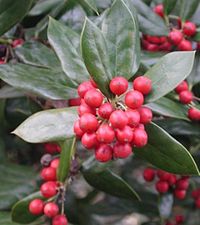Ilex cassine
| Ilex cassine subsp. var. | Dahoon Holly, Cassena | |||||||||||||||||||||||||||||||||||||||||||||||||||||||
|---|---|---|---|---|---|---|---|---|---|---|---|---|---|---|---|---|---|---|---|---|---|---|---|---|---|---|---|---|---|---|---|---|---|---|---|---|---|---|---|---|---|---|---|---|---|---|---|---|---|---|---|---|---|---|---|---|

|
|
| ||||||||||||||||||||||||||||||||||||||||||||||||||||||
| ||||||||||||||||||||||||||||||||||||||||||||||||||||||||
Ilex cassine (Dahoon Holly; also sometimes known as Cassena, but see also Ilex vomitoria), is a holly native to the southeastern coast of North America, in the United States from Virginia to southeast Texas, in Mexico in Veracruz, and in the Caribbean on the Bahamas, Cuba, and Puerto Rico.[1]
It is a large shrub or small tree growing to 10-13 m tall. The leaves are evergreen, 6-15 cm long and 2-4 cm broad, glossy dark green, entire or with a few small spines near the apex of the leaf. The flowers are white, with a four-lobed corolla. The fruit is a red drupe 5-6 mm diameter containing four seeds.[2][3][4]
As with other hollies, it is dioecious with separate male and female plants. Only the females have berries, and a male pollenizer must be within range for bees to pollinate them.
It is grown as an ornamental plant for the attractive bright red berries set against the glossy green leaves. Its original range was close to the coast, but the range has been extended by planting.
| Standard Cyclopedia of Horticulture |
|---|
|
Ilex cassine, Linn. (I. dahoon, Walt.). Dahoon. Shrub or small tree, to 30 ft.: lvs. obovate to oblong- linear, acute or obtuse and mucronulate, entire or sharply serrate above the middle, usually pubescent beneath when young, 2-3 in. long: fr. globose, small, dull red, rarely yellow, on this year's growth. April, May. N. C. to Fla., west to La. S.S. 1:46. Ilex cassine var. angustifolia, Ait. Lvs. linear-oblong to linear, 2-3 in. long. Ilex cassine var. myrtifolia, Chapm. Lvs. linear-oblong, 1-2 in. long: fr. usually solitary.—Cassine or cassena is the name in the language of the Timucua Indians for an exhilarating beverage prepared from the lvs. of the following plant which had been confused with this species; the name seems to have been borrowed from the Muscogee word assi, leaves, modified by a prefix.
|
Cultivation
Propagation
Pests and diseases
Varieties
- Ilex cassine var. cassine. United States, Caribbean.
- Ilex cassine var. angustifolia Aiton. United States.
- Ilex cassine var. mexicana (Turcz.) Loes. Mexico.
Gallery
-
photo 1
-
photo 2
-
photo 3
References
- ↑ 1.0 1.1 Germplasm Resources Information Network: Ilex cassine
- ↑ Florida Department of Environmental Protection: Florida's Hollies
- ↑ Huxley, A., ed. (1992). New RHS Dictionary of Gardening. Macmillan ISBN 0-333-47494-5.
- ↑ Ilex cassine Fact Sheet
- Standard Cyclopedia of Horticulture, by L. H. Bailey, MacMillan Co., 1963
External links
- w:Ilex cassine. Some of the material on this page may be from Wikipedia, under the Creative Commons license.
- Ilex cassine QR Code (Size 50, 100, 200, 500)
